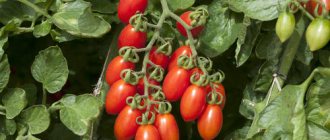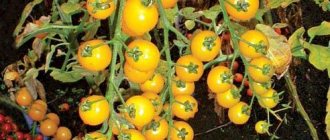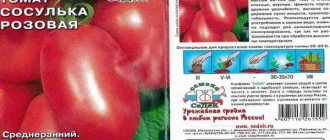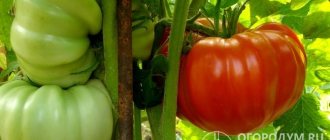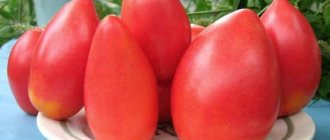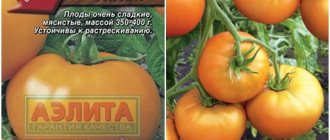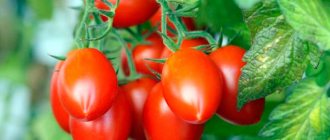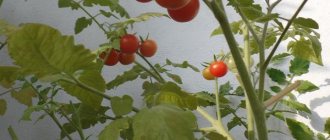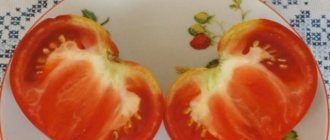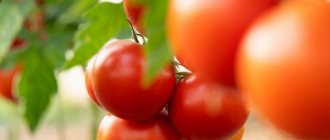The tall Altai Pink variety will give the gardener delicious, sugary salad tomatoes, of which there will be so many that the branches will bend under their weight.
| Height | Landing location | Ripening time | Fruit color | Fruit size | Origin | Fruit shape |
| Tall | Open ground | Mid-season | Pink | Large | Variety | Flat-round |
Description of pink tomato
The Altai pink tomato variety is a late-ripening hybrid with a large amount of sugars and dry substances. The fruits are rich in amino acids, lycopene, and beta-carotene. Tomatoes help improve health and improve immunity. They are used for dietary nutrition.
Altai pink tomato bushes are indeterminate and reach two meters in height. The plant is characterized by a small number of leaves, but they are large and dark green in color. The variety is productive; from one square meter you can collect an average of 10 kilograms of tasty fruits. The variety's clusters contain 4-6 tomatoes weighing 300-500 g. With proper agricultural technology, the harvest is harvested from mid-summer until frost.
The fruits of the variety have a flattened shape with ribbing at the base. When unripe, the fruit has a dark green spot near the stalk. The skin of the variety is dense.
The plant is suitable for growing in open ground and in greenhouses.
Origin and application
The Altai tomato variety was bred by Russian breeders. Recommended for growing in open ground and under film, in glass and polycarbonate greenhouses. The collected fruits are well stored and can be transported.
Tomatoes are used for amateur or industrial cultivation and are excellent for sale. Tomatoes picked green ripen quickly at room temperature. Tomatoes of the Altai red, pink and orange varieties belong to the salad type. Fleshy, juicy fruits are delicious fresh; they are used to make sandwiches, sauces, soups, and purees.
Ripe tomatoes produce delicious sweet juice that can be drunk freshly squeezed or stored for future use. From three varieties of tomatoes you can make a tasty and beautiful vegetable platter; the tomatoes are salted and pickled. They go well with other vegetables: cucumbers, peppers, cauliflower.
Advantages and disadvantages
The Altai pink tomato has few negative qualities. The main negative quality is the dependence on the type of soil, tying and the need for pinching. When you decide to plant a variety on your site, you should know that it is not suitable for canning.
Despite all the disadvantages, tomato has many advantages:
- has high resistance to diseases;
- tolerates drought and cold climates well;
- gives a stable harvest;
- excellent transportability of fruits;
- excellent taste;
- long fruiting.
Amateurs and professionals give positive reviews about the Altai pink tomato. With good agricultural technology, the fruits are large. Growing tomatoes begins with sowing seeds for seedlings. Also, in advance, in the fall, they prepare a place for planting.
Landing
Growing seedlings begins with sowing seeds. For planting, you can use a substrate consisting of peat, sand and soil in a ratio of 2:1:1.
For better growth of seedling roots, 25-30 g of superphosphate per 10 liters of substrate is added to the mixture.
Before sowing, to speed up germination, seeds are soaked overnight in 0.02% succinic acid. After this, they are treated for 20 minutes with 1% potassium permanganate, washed, dried until crumbly and sown.
A gram of tomato seeds contains 200-280 pieces. They produce 180-250 full-fledged seedlings. When growing seedlings, it is necessary to provide a 10% safety margin.
Immediately after sowing, the temperature in the room is maintained at 25-30 degrees. With three-day germination on damp cloth or paper, seedlings will appear in 1-2 days, without germination - in 5-7 days. Immediately after the leaves appear on the surface, the temperature is reduced to 16 degrees. After 4-5 days, they increase it to 19-22 degrees and continue cultivation in this mode until planting in the garden.
When the cotyledon leaves on the seedlings are fully expanded (usually this happens 10-12 days after emergence), the seedlings are dropped into prepared pots filled with a nutrient mixture. The day before picking, water the soil generously - this will make it easier to extract the roots from the soil. Weak plants that are lagging in development are discarded.
Seedlings that have reached the age of 55-60 days are planted in the ground. Each hole is filled with a handful of humus and a tablespoon of superphosphate. Immediately after planting, the plants are watered with warm water.
The Altai pink planting scheme is one-line. The distance between plants is 50 cm, row spacing is 70 cm.
Soil preparation
The soil for tomatoes should be prepared in the fall by adding compost and ash. Tomatoes feel good on lands with a high content of organic matter, potassium, and nitrogen. These plants perform best in slightly alkaline soil. In order for the soil to acquire the desired pH level, ash is added to it. It has an alkaline reaction and contains up to 5% potassium.
Tomato seedlings grow faster if the bed is preheated. In open ground, this is achieved by covering the bed with film or other covering material.
When planting seedlings, do not be afraid to deepen them to the first leaves. This will help build a strong root system.
Bush formation
As stated in the description, the “Altai pink” tomato is a tall variety. Such plants need tying and shaping. It is best to grow the plant in 1-2 stems. In addition to pinching, it is necessary to remove all lower leaves to each ovary. As a result of proper formation, the bush will have 3-4 leaves, which will be enough for it to carry out photosynthesis and for nutrition. This formation provides better access of air and light to the plant, and also helps reduce the risk of fungal diseases. Formation helps to obtain an early, abundant harvest, since removing leaves allows resources to be used specifically for fruit formation.
In hot regions, it is not recommended to remove the leaves too much, as they protect the fruits from sunburn and overheating. It is recommended to remove leaves as the bush is harvested.
Agricultural technology of Altai orange tomatoes
Mostly in all regions of Russia, Altai orange tomato is grown through seedlings. Only in the Southern regions is planting directly into open ground allowed. Vegetable growers claim that growing home seedlings is no different from other varieties and does not cause any trouble.
Sowing of seedlings is carried out in March. The best time is from the 1st to the 20th, but timing may vary. The main condition is that at the time of planting, the age of the seedlings must be at least 60 days and no more than 65. Overgrown bushes do not adapt well.
Landing rules
Experienced summer residents and tomato producer Agro recommend planting seedlings in a greenhouse so that per 1 sq. m accommodated no more than 3 plants. This greatly affects the yield of the variety.
Warning! In an open garden bed, 4 bushes per 1 square meter are allowed. m.
Leave a distance of about 40 cm between plants to make it easier to care for the bushes. Between rows - at least 50 cm.
The seedlings are transplanted into the greenhouse no earlier than the end of April or the beginning of May, by which time the soil should warm up to a temperature of +15 °C. If the soil freezes to +10 °C, then the seedlings slow down. With prolonged cold weather it dies.
The Altai orange tomato variety is transferred to open ground in early June, taking into account the weather conditions in the growing region.
Holes for planting are made in advance. Transplantation is carried out using the transshipment method. Only overgrown seedlings are buried. Immediately after the procedure, you need to tie up the stems of the plants. However, this can be postponed for 5-10 days until the bushes take root well.
Watering and fertilizing
As mentioned earlier, the yield of Altai orange tomatoes depends on proper care, so special attention is paid to watering and fertilizing the plants.
The first watering is carried out immediately after planting, after which the soil is mulched. There is no need to additionally moisten the soil for the next 2 weeks; the seedlings should take root. After this period, the usual scheme for plants of this variety is established:
- 1 time every 3 days for greenhouses;
- Once every 5 days for open ground.
In greenhouses, the soil dries out faster, so you will have to water more often. But in open ground, you need to take into account weather conditions and the amount of natural moisture. If it rains, there is no need to additionally water the Altai orange tomato. With this watering regime, the fruits do not crack.
The Altai orange variety responds well to fertilizing. They are made several times during the season:
- during the formation of the first flower cluster;
- at the moment of formation of the ovary;
- during the fruiting period.
For the first time, tomatoes are fed with mullein solution, after which superphosphate and ash are used. The last time potassium and phosphorus mixtures are added.
Throughout the entire growth period, foliar feeding can be done, which has a good effect on fruit formation and yield. You can use drugs like “Ovary” or “Tomaton”.
Pinching and tying
Plants of the variety require obligatory pinching. The stepsons are removed when they grow 1-2 cm, but they are not allowed to grow up to 5 cm. They are cut with a sharp knife so that a stump remains, then the stepsons will no longer appear from this sinus.
In addition to the stepsons, you need to remove the lower leaves from the bushes so that they are well ventilated. This prevents the occurrence of fungal diseases and various viral infections.
Tie the stems to the supports immediately after the tomatoes take root in the garden. Subsequently, the shoots are twisted around the twine until they reach the top of the support.
Formation
Altai orange tomato can be formed in two ways:
- in one stem;
- in two or more escapes.
If the goal is to get as many tomatoes as possible, then the bush is grown in two shoots. But it is worth remembering that with this method the weight of the tomato will be average.
Larger specimens can only be grown when the plant is formed into one stem. Experienced gardeners receive tomatoes weighing from 500 to 700 g. But there are not many of them.
Protection from diseases and pests
Judging by the reviews and photos of Altai orange tomatoes, the crop rarely gets sick and bears fruit consistently. However, to prevent fungal diseases, planned measures are required.
Gardeners note the high resistance of the crop to the following ailments:
- fusarium;
- tobacco mosaic;
- verticillium wilt;
- top and root rot;
- late blight
However, during cultivation, the bush is attacked by pests. Among them the most annoying are:
- aphid;
- whitefly;
- Colorado beetle;
- spider mite;
- thrips.
For prevention purposes, Altai orange tomato is treated with insecticides. If the number of pests is small, you can try using folk remedies:
- ash solution;
- tobacco dust;
- ammonia solution.
It is better to collect Colorado beetles by hand, without allowing individuals to reproduce.
Diseases and pests
Diseases are a big problem when growing tomatoes, regardless of the region in which they are grown. The most dangerous diseases of tomatoes are late blight, brown spot, blossom end rot, and tobacco mosaic. They usually occur due to rain and lack of heat. The combination of rain and cold can be very damaging to tomatoes.
To exclude diseases, it is recommended to follow certain rules of prevention:
- It is recommended to plant zoned varieties.
- To grow plants, it is recommended to use hybrids and varieties from reliable producers.
- It is best to grow tomatoes in protected conditions: greenhouses, greenhouses.
- Maintain crop rotation. If it is impossible to change the top part of the soil.
- At the slightest damage to plants, immediately remove diseased bushes.
- Remove weeds.
- Stepchildren, remove leaves only in dry weather.
Watering plants
To get an “Altai pink” tomato like in the photo, you must follow the watering rules. These plants need infrequent but abundant watering. This promotes the formation of a deep branched root system.
With excessive watering, the fruits become sour in taste, may crack, and the plants are affected by fungal diseases. Lack of moisture leads to blossom end rot.
When watering, it is important to avoid getting water on the bush, leaves, or fruits, as this leads to the development of a fungal infection.
The ideal means of irrigation is a drip system. It helps maintain the optimal level of humidity necessary for normal growth and development of plants.
Features of growing and caring for pink tomatoes
Pink tomatoes are more demanding to care for than red ones, but in turn they are also more tasty. To grow them you need several subtleties in growing:
- They need more abundant watering and frequent feeding. The soil must be moist, as a lack of moisture leads to shrinkage of the fruits.
- In turn, an excess of moisture is undesirable for many varieties, due to the susceptibility of the fruit to cracking.
- The crust that forms on the soil after watering interferes with the saturation of the roots with oxygen, which impairs the development of the plant and future productivity. After each watering, the soil must be loosened, removing any weeds that have appeared.
- Plants need to be fed with complex mineral and organic fertilizers.
- Preventive spraying against diseases and pests allows you to completely protect plants and the future harvest.
- Due to the large-fruited nature of pink tomatoes, almost all varieties require tying and shaping.
- Pinching is a necessary condition for good fruiting. If you follow these simple care conditions, you can grow an excellent and healthy harvest.
All varieties of pink tomatoes, with good care, give an excellent harvest. Regardless of where they grow, tomatoes always delight with their excellent taste and bright color of the fruit.
Tomato Pink Cube F1 has managed to gain a reputation as a highly productive and unpretentious hybrid among summer residents and farmers. Tomatoes look attractive, have excellent taste and commercial quality.
| Height | Landing location | Ripening time | Fruit color | Fruit size | Origin | Fruit shape |
| Tall | Greenhouse, Open ground | Early ripening | Pink | Average | Hybrid | Plum-shaped or oval |
Fertilizer application
According to reviews, the “Altai pink” tomato, the photo of which is presented in the article, needs good feeding. From the period of seedling picking until the beginning of flowering, it is necessary to carry out one comprehensive plant feeding. To do this, you can use mineral fertilizers or use mullein.
After the first fruits are formed, fertilizer containing potassium is applied. For convenience, it is recommended to use mineral fertilizer granules that are mixed with the soil. The granules, while in the soil, dissolve for a long time, supplying the plant with the required amount of nutrients.
Growing tomatoes
The best way to grow Altai tomatoes is from seedlings.
Tomato Altai Red:
How to prepare seeds
Pre-sowing disinfection of seed material is carried out in a manganese solution, after which the seeds are washed and dried. After the disinfection procedure, the seeds are treated in a growth stimulator, which significantly increases the germination of the seeds.
Sowing seed material
How to sow seeds correctly:
- The soil mixture for seedlings includes garden soil with humus or peat. It is permissible to add a small portion of washed river sand, superphosphate and wood ash;
- For sowing, give preference to containers or peat cups with a slight depth. After planting, the seeds are sprinkled with peat and sprayed with water;
REFERENCE: Sowing in individual containers allows you to avoid further picking.
- Containers with plantings are covered with film and placed in a warm place. In order for the seeds to germinate, it is necessary to maintain a temperature of at least +25 ºС.
Rules for planting seedlings
How to plant seedlings:
- It is recommended to plant seedlings in beds after legumes, cabbage, lettuce, carrots or other cruciferous vegetables. You should not plant after eggplant, physalis or pepper;
REFERENCE: If this is not possible, replace the top layer of soil by mixing it well with peat or humus.
- Before planting, the soil is loosened;
- The seedlings are planted in holes, which are placed at a distance of 40-50 cm from each other. The row spacing should be 70-80 cm;
- Superphosphate is added to the wells, which is mixed with potassium salts or wood ash (at the rate of one tablespoon per bush);
- During transplantation, supports are installed near each bush for further tying up of tomatoes.
Tomato varieties:
Humidity, temperature, light
For the successful development of tomatoes, an average daily temperature of 18-25 degrees is ideal. At lower temperatures, growth slows down, and at higher temperatures, plants begin to burn.
Direct sun is necessary for plants only in the initial stages of flower formation, and during the flowering period and during the formation and ripening of fruits, tomatoes require heat.
Free movement of dry heat around developing tomatoes is the main condition for disease prevention. To ensure air movement in the greenhouse, it is necessary to ventilate it on hot days.
Pollination
According to reviews, the yield of the “Altai pink” tomato, photos of which show large, fleshy fruits, can be increased if flowers are pollinated by hand. In general, these plants belong to self-pollinating crops. However, to ensure that the plant produces a large number of tomatoes, during flowering it is recommended to shake each plant once every two days, holding it by the stem.
When growing tomatoes outdoors, you can attract pollinating insects. To do this, bright annual flowers are planted between the rows. Marigolds and monarda are considered the best. They attract butterflies and bees. According to many gardeners, growing vegetables and flowers together improves the taste of tomatoes.
The crop should be harvested when it is fully ripe. You can pick tomatoes at the browning stage, but in this case they should be given the opportunity to ripen by placing them in boxes along with apples or bananas or ripe tomatoes.
Description of the Altai Pink tomato variety, yield
Altai varieties are suitable for those gardeners who want to add a little variety. In total, the variety has three shades: yellow, pink and red. The taste and description of the variety are similar.
Characteristics of the variety
This variety of tomato is late-ripening and has good yield. Ripening time is 110 – 115 days. The harvest begins from mid-summer until the onset of the first frost.
An adult plant reaches a height of about one and a half meters. It has large dark green leaves. 4–6 fruits grow on a bush, weighing up to 300 g. The tomato is distinguished by its fleshy and juicy pulp, and has a thin but dense peel. The peel, like the pulp, is warm pink.
Origin and use
The variety was bred by Russian specialists. You can grow tomatoes both in open ground and under film. The resulting harvest is stored for a long time and tolerates transportation well. Tomatoes of this variety are grown for personal and industrial use. Unripe tomatoes ripen quickly if the fruit is stored at room temperature.
The Altai tomato variety is classified as a salad type, which allows the tomatoes to be used in the preparation of sandwiches, salads, juice, soups, and purees. The fruits of this variety make excellent winter preparations.
Positive and negative features of Altai tomato
The Altai pink tomato has many advantages:
- The variety is resistant to various diseases, which reduces the financial and time costs of growing tomatoes.
- Tolerates any vagaries of weather, from drought to rainy summer.
- Not picky. Cultivation and care require a minimum of effort and time.
- High yield, which allows you to obtain a large harvest of tomatoes in small areas.
- Tomatoes have good taste.
The disadvantages of tomatoes of this variety include the need to tie up and shape the bushes and the fact that the yield strongly depends on the amount of fertilizing and the type of soil.
Features of cultivation
The variety has good reviews. Tomatoes are recommended to be planted as seedlings in open ground. Before planting, the seeds must be disinfected by immersing them in a solution of potassium permanganate. After the procedure, the seeds are washed, dried, and doused with special agents that stimulate growth and increase the number of seedlings.
Tomato prefers soil from the garden, where fertilizers or peat are added. Sometimes a small amount of sand or ash is introduced. Containers and small containers with peat are well suited for sowing. If we plant seeds in cups, we need to sprinkle peat on top and spray them with water.
If you plant the tomatoes in different containers, you won’t need to pick up the seedlings in the future. Cover the container with film and place in a warm place. For good germination, it is necessary to provide a temperature of 25 degrees.
Seedlings are planted in the ground where cruciferous plants previously grew. It is not recommended to plant where peppers or eggplants were grown in the past. If there is no suitable place, the top layer of soil in the greenhouse is replaced with a new one containing sand and peat. Tomatoes should be planted in well-loose soil. The seedlings are planted in holes, the distance between which should be approximately half a meter, and the row spacing should be 70 centimeters.
Before planting, fertilizers are sprinkled over the holes. Near each hole, supports are placed, for which stakes or rods are used, sometimes trellises. In the future, tomato bushes will be tied to them.
For irrigation, use warm water, which should be left for 24 hours. Watering is carried out as needed, as soon as the top layer of the base dries. Between irrigations, the soil should be loosened, otherwise a crust will form on the surface, which will not allow air to pass to the roots. Throughout the season it is necessary to fertilize, only three to four times. Organic compounds and mineral complexes are used as fertilizers.
During the formation of the bush, it is necessary to leave one or two stems, all excess stepsons are removed. If the plant is too elongated, the top is cut off. The lower leaves are removed, improving air exchange. In addition, the fruits receive more light this way. Some gardeners remove low-quality flowers.
Diseases and pests of tomatoes
This variety of tomato has a strong immunity to tomato diseases and harmful insects, but it is better to carry out preventive measures periodically. For this purpose, you should water the bushes with a solution of copper sulfate and potassium permanganate.
To avoid root rot, the base is constantly loosened, removing weeds. Mulching with various materials, such as straw, peat or humus, helps.
Sometimes tomato bushes are attacked by pests. Most often this happens when the tomato produces flowers. For prevention, it is necessary to inspect all tomato bushes weekly. To combat insects, tomatoes are sprayed with poison or a solution of potassium permanganate. The use of chemical toxins is permissible only before fruiting begins, and during the period of fruit ripening, pest control is carried out using folk remedies.
Harvesting
The harvest must be harvested regularly, every 4 to 5 days, depending on the time of ripening. This way the tomato bush will have more strength to develop and ripen other tomatoes. If a defective fruit is noted on the bush, the marriage should be disrupted so that it does not take away the strength of the bush.
Tomatoes are divided into green, milk, brown and pink. They are torn off depending on the purpose of further use. If the tomatoes are to be eaten fresh, only the pink fruits should be picked. For storage it is necessary to collect brown or milky ones. If you plan to store tomatoes for a long time, it is better to leave the stalk, otherwise a wound will form into which bacteria can enter, causing the tomato to rot.
The excellent characteristics of the Altai tomato make it possible to grow this variety in any region, obtaining an excellent harvest. If you properly care for the garden bed, tomato bushes will delight the grower with fruits all season long. From ripe tomatoes you can collect seeds for further sowing.
